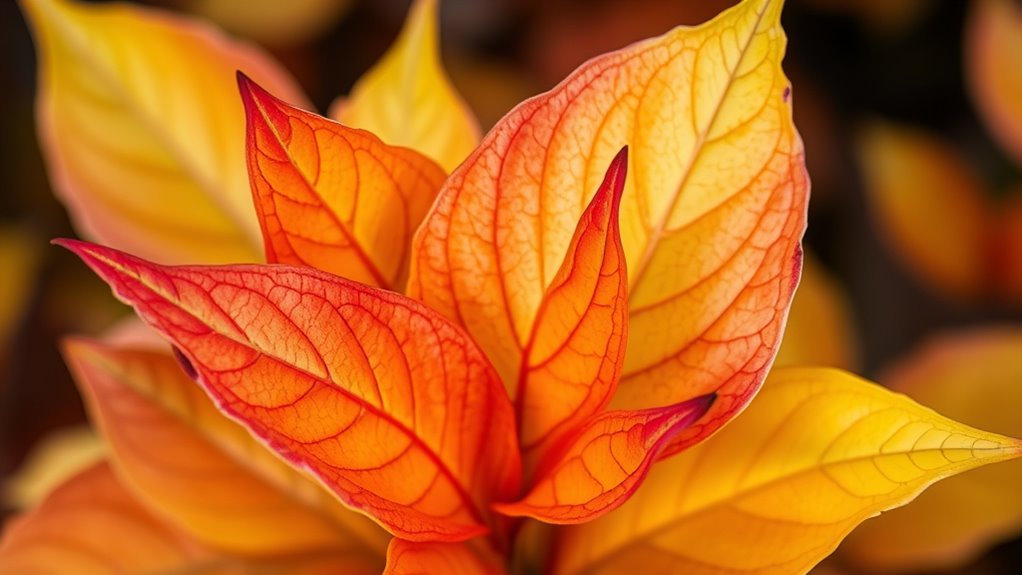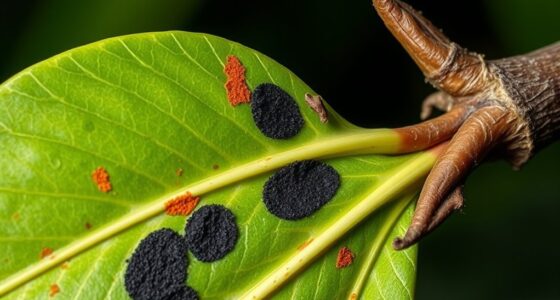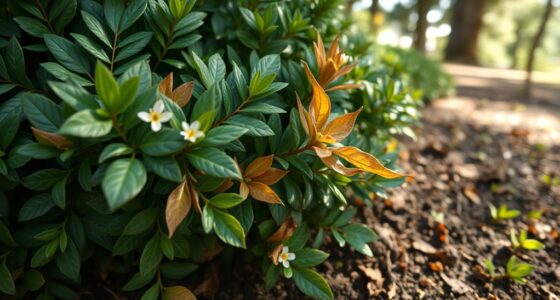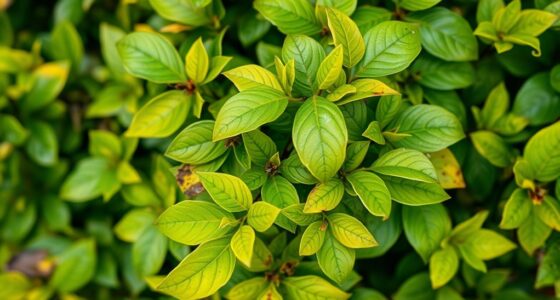Yellowing leaves on your burning bush can indicate either chlorosis or root stress, both caused by issues like nutrient deficiencies, poor soil conditions, or overwatering. Look for signs such as yellowing starting at leaf tips, thin or brittle leaves, or drooping, wilted foliage. Examining soil health, root condition, and nutrient levels can help determine the cause. Continue exploring to identify the exact issue and discover effective solutions to restore your bush’s health.
Key Takeaways
- Examine leaf discoloration patterns: yellowing from tips or edges suggests chlorosis; patchy yellowing indicates root stress.
- Check for green veins amid yellow leaves to identify chlorosis caused by nutrient deficiencies.
- Inspect roots for signs of damage, rot, or pests, which point to root stress as the cause.
- Conduct soil tests to assess pH, nutrient levels, and drainage, helping differentiate between chlorosis and root issues.
- Observe overall plant health: wilted, drooping leaves with poor growth often indicate root stress, while thin, brittle leaves suggest chlorosis.
Recognizing the Signs of Yellowing Leaves on Your Burning Bush
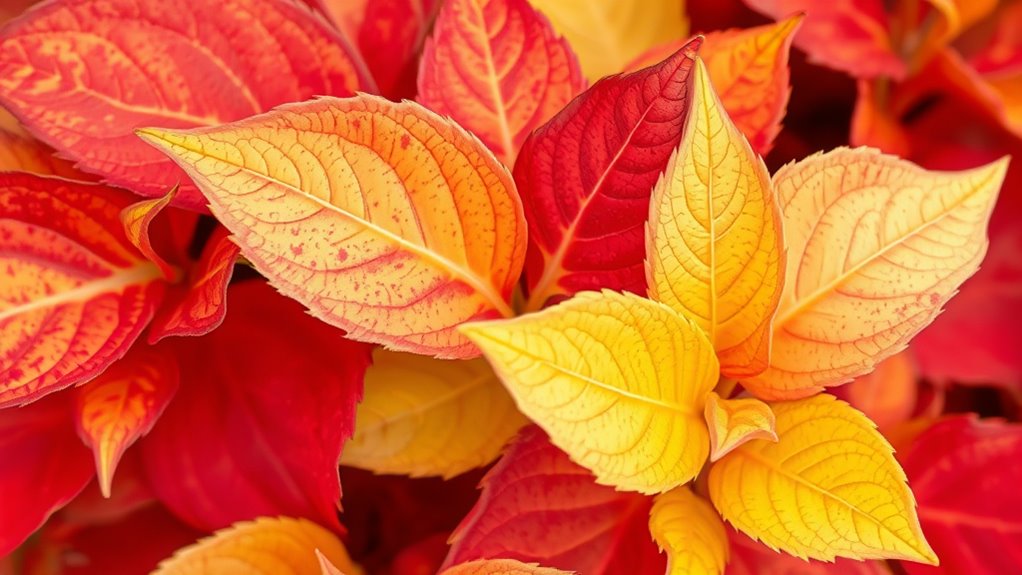
If you notice your burning bush’s leaves beginning to turn yellow, it’s a clear sign that something may be wrong. Start by inspecting your plant closely for pests or signs of disease. Effective pest management is vital, so look for insects like aphids or scale that can cause stress and yellowing. Pruning techniques can help remove damaged or diseased branches, promoting healthier growth and improving airflow. Use clean, sharp tools to cut back affected areas, preventing the spread of pests or disease. Regularly monitor your plant’s health, and don’t hesitate to remove any heavily infested or dead foliage. Proper pruning and pest control can reduce stress on your burning bush, helping it recover and maintain vibrant, healthy leaves. Additionally, understanding plant health fundamentals can help you better diagnose and address issues early. Recognizing environmental stressors such as improper watering or soil problems is also crucial in preventing yellowing leaves. Paying attention to soil quality and ensuring proper drainage can further support your plant’s recovery.
Understanding Chlorosis and Its Impact on Plant Health

Chlorosis occurs when your burning bush can’t produce enough chlorophyll, causing leaves to turn yellow. You might notice other signs like leaf thinning or poor growth, which indicate underlying issues. Understanding what causes chlorosis and how to manage it is key to restoring your plant’s health. Recognizing plant care practices can help prevent or address chlorosis effectively. Additionally, considering cultural impact can shed light on how environmental factors influence plant health. Proper soil conditions and nutrient availability play a vital role in preventing deficiencies that lead to chlorosis.
Chlorosis Causes and Symptoms
When a plant’s leaves turn yellow, it often signals chlorosis, a condition caused by insufficient chlorophyll production. This can result from nutrient deficiencies, poor soil conditions, or root stress. You might notice yellowing starting at the tips or edges of leaves, sometimes with green veins remaining visible. Symptoms can also include stunted growth and leaf drop. To address chlorosis, proper pruning techniques can help improve airflow and reduce stress on the plant. Pest control is essential if pests like aphids or scale insects are damaging roots or leaves, further hindering nutrient uptake. Identifying the cause early allows you to take targeted action, preventing further decline and helping your plant recover its health.
Chlorosis Management Strategies
Understanding how to manage chlorosis is essential for maintaining your plant’s health and preventing long-term damage. Start with proper pruning techniques to remove severely affected or dead branches, encouraging new, healthy growth. Regular pruning also improves air circulation, reducing the risk of pests that can worsen chlorosis. Pest control is crucial; inspect your plant frequently and address infestations promptly with appropriate methods, such as organic insecticides or natural predators. Additionally, guarantee your plant receives balanced fertilization, focusing on iron supplements if deficiency is suspected. Incorporating integrated pest management practices into your plant care routine can help prevent pest-related stress that exacerbates chlorosis. Avoid overwatering or underwatering, which stresses roots and exacerbates chlorosis. Ensuring proper watering techniques also supports overall plant health. Incorporating data privacy considerations into your plant management practices can help protect sensitive information related to your gardening activities. Consistent monitoring and an integrated approach combining pruning, pest control, and proper nutrition will help restore your plant’s vitality and prevent future issues.
Identifying Root Stress and Its Symptoms in Shrubs

Roots under stress often struggle to supply nutrients and water efficiently, leading to visible signs of decline in your shrubs. You might notice yellowing leaves, stunted growth, or wilting despite adequate watering. Look for root damage, which can occur from physical injury or disease, causing roots to become damaged or decayed. Soil compaction is another key factor; it restricts root growth and reduces oxygen availability, resulting in poor nutrient uptake. Signs of root stress include a weak or spongy root system when you gently examine the soil or roots. You may also see increased leaf yellowing or browning, especially in the lower parts of the shrub. Recognizing these symptoms early helps you address root issues before they severely impact your plant’s health. Additionally, understanding the importance of soil aeration can help prevent compaction and promote healthier root systems. Improving soil structure through proper aeration techniques can significantly reduce root stress and improve plant vitality. Regularly testing your soil’s pH and nutrient levels can also identify deficiencies that contribute to leaf discoloration and overall plant decline.
Common Causes of Nutrient Deficiencies in Burning Bushes

Root stress in burning bushes can lead to nutrient deficiencies that compromise their overall health and appearance. Common causes include fertilizer deficiency, which limits essential nutrients needed for lush growth. Pest infestation also plays a role, damaging roots or leaves and disrupting nutrient uptake. To understand these causes better, consider this table:
| Cause | Effect | Solution |
|---|---|---|
| Fertilizer deficiency | Yellowing leaves, weak growth | Regular balanced fertilizing |
| Pest infestation | Root damage, nutrient blockages | Implement pest control |
| Poor soil quality | Reduced nutrient availability | Improve soil with organic matter |
Addressing these issues promptly helps restore your burning bush’s vibrant foliage and overall energy.
How Overwatering and Poor Drainage Affect Your Plant
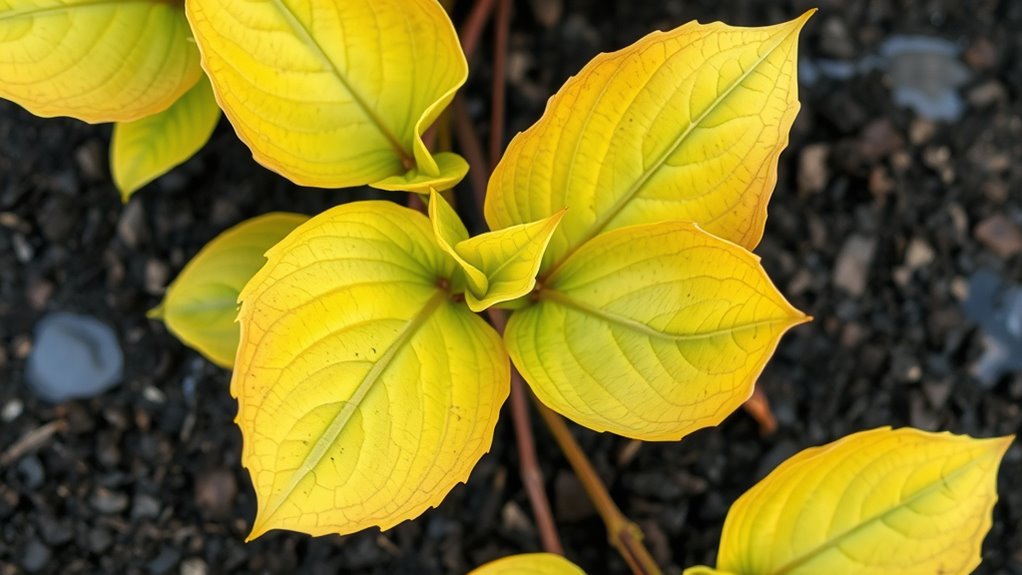
Overwatering and poor drainage can quickly harm your burning bush by suffocating its roots and causing waterlogged soil. When roots sit in excess water, they can’t access oxygen, leading to root rot and yellowing leaves. To prevent this, use proper pruning techniques to remove dead or damaged roots and encourage healthy growth. Additionally, overwatering can attract pests like fungi and insects, so pest control becomes essential. Make certain your soil drains well by amending it with organic matter or installing drainage systems. Avoid watering excessively; instead, check soil moisture before watering. Maintaining good soil health and balancing watering habits are crucial for preventing stress-induced yellowing. Also, understanding plant stress signals can help you identify issues early and take corrective action. Recognizing the signs of relationship issues such as neglect or miscommunication can prevent further stress on your plant. Keeping your plant healthy involves balancing watering habits and maintaining good drainage, which ultimately keeps your burning bush vibrant and prevents stress-induced yellowing.
Diagnostic Techniques to Differentiate Between Chlorosis and Root Stress

To figure out whether your burning bush’s yellowing leaves are caused by chlorosis or root stress, start by examining the plant’s visual symptoms carefully. You should also perform soil and water tests to check for nutrient deficiencies or improper drainage. These techniques help you identify the true cause and determine the best treatment approach. Additionally, understanding signs of spoilage in lemon juice can help ensure any treatments or supplements used are safe and effective.
Visual Symptoms Analysis
How can you tell if yellowing leaves on a burning bush result from chlorosis or root stress? Start by examining foliage discoloration. Chlorosis typically causes uniform, pale yellowing across the leaves, often with a loss of green coloration in veins. In contrast, root stress may produce patchy or uneven foliage discoloration, with some areas turning yellow while others stay green. Pay close attention to leaf morphology: chlorotic leaves tend to be thin, small, and may curl or become brittle, whereas stressed roots often lead to leaves that are wilted, drooping, or misshapen. Look for patterns—consistent, even yellowing suggests chlorosis, while irregular, patchy discoloration hints at root problems. These visual symptoms can guide you toward the underlying cause of the yellowing leaves. Additionally, proper diagnosis techniques such as soil testing or root inspection can help confirm whether nutrient deficiencies or root health issues are at play. Recognizing plant stress signals can further aid in diagnosing the issue accurately and taking appropriate corrective actions. To better understand the causes, understanding the AI advancements in plant diagnostics, like remote sensing and image analysis, can provide more precise insights.
Soil and Water Tests
Conducting soil and water tests is essential for accurately diagnosing whether yellowing leaves on a burning bush stem from chlorosis or root stress. By testing soil pH, nutrient levels, and moisture content, you can determine if deficiencies or imbalances are causing the problem. If soil tests reveal poor drainage or low nutrients, applying appropriate soil amendments can improve conditions. Water tests help identify issues like overwatering or drought stress, guiding proper watering practices. Additionally, testing can uncover pest control issues affecting root health. Proper diagnosis allows you to target solutions effectively, whether adjusting soil amendments, improving drainage, or managing pests. Incorporating soil health assessment techniques from hackathons or other collaborative environments can provide innovative ways to improve your plant care practices. This proactive approach helps restore your burning bush’s health and prevents future stressors from causing leaf yellowing.
Effective Treatments and Care Strategies for Yellowing Leaves

When your burning bush’s leaves start turning yellow, addressing the issue promptly can help restore its health. Start by using proper pruning techniques to remove any dead or diseased branches, which encourages healthy growth and improves airflow. This reduces the risk of pest infestations that can stress the plant further. Regular pest management is essential; inspect leaves for signs of insects like aphids or scale, and treat infestations with appropriate insecticides or natural remedies. Make certain you’re providing adequate water and avoid overwatering, which can worsen root stress. Fertilize with a balanced, slow-release fertilizer if needed. By combining timely pruning, vigilant pest control, and proper watering, you’ll give your burning bush a strong chance to recover and regain its vibrant foliage.
Preventative Measures to Keep Your Burning Bush Healthy
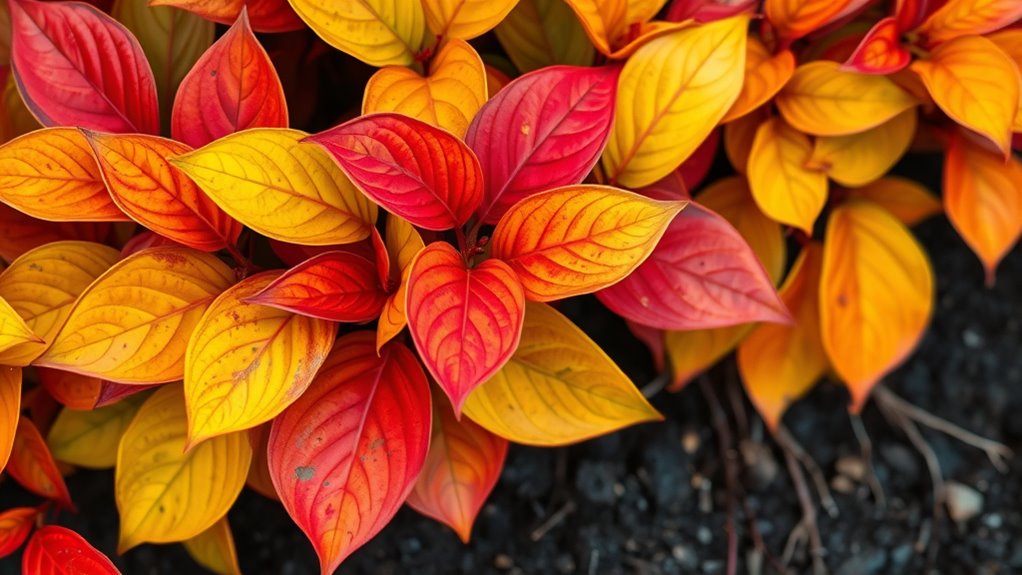
To keep your burning bush healthy and prevent yellowing leaves, it’s important to establish a routine of preventive care. Regular pruning techniques help improve air circulation and remove dead or diseased branches, reducing stress on the plant. Additionally, consistent pest control ensures pests don’t weaken the shrub and cause yellowing. Here are three key steps:
- Schedule seasonal pruning to promote healthy growth and remove overcrowded branches.
- Monitor for pests like aphids or scale insects, and treat infestations promptly with appropriate solutions.
- Maintain proper watering and soil health to prevent root stress, which can lead to chlorosis and yellow leaves.
Frequently Asked Questions
Can Yellow Leaves Indicate Pests Instead of Nutrient Issues?
Yellow leaves can sometimes signal pests like insect infestation, which cause stress and damage to your plant, or fungal disease, that affects leaf health. If you notice pests or fungal growth, it’s likely a pest or disease issue rather than nutrient deficiency. You should inspect your burning bush closely for insects or fungal spots. Proper treatment will help restore your plant’s health and prevent further yellowing.
How Does Soil Ph Influence Burning Bush Leaf Color?
Soil pH critically influences your burning bush’s leaf color by affecting nutrient uptake. If the soil is too acidic or alkaline, it hampers the plant’s ability to absorb essential nutrients, leading to yellowing leaves. Maintaining proper soil acidity ensures ideal nutrient availability, helping your burning bush stay healthy and vibrant. Test your soil regularly and adjust pH levels as needed to promote better nutrient uptake and prevent color issues.
Are There Specific Fertilizers That Prevent Chlorosis?
Imagine finding the perfect miracle fertilizer that banishes yellow leaves forever! While no single fertilizer type can guarantee this, nutrient supplements rich in iron, manganese, and zinc can help prevent chlorosis. Look for chelated forms of these elements, as they’re easily absorbed. Regularly applying these specialized fertilizers boosts your burning bush’s health, ensuring lush, vibrant leaves and preventing that dreaded yellowing caused by nutrient deficiencies.
What Role Do Watering Schedules Play in Root Stress?
You need to manage your watering schedule carefully to prevent root stress. If you water too frequently, soil moisture stays too high, which can suffocate roots and cause stress. Conversely, infrequent watering leads to dry soil, stressing roots and affecting plant health. Maintaining consistent soil moisture with appropriate watering frequency helps roots absorb nutrients properly, reducing yellowing leaves and promoting overall plant vigor. Proper watering is essential for healthy, stress-free roots.
Can Pruning Improve Yellowing Leaves Caused by Root Problems?
Imagine giving your burning bush a gentle nudge toward liveliness—pruning benefits are undeniable. While pruning can’t directly fix root stress, it can improve overall plant health, making it easier to manage. By removing damaged or crossing branches, you promote better airflow and growth. This aids root stress management indirectly, helping your plant recover and keep its vibrant leaves. So, yes, thoughtful pruning can support your bush’s recovery from root-related issues.
Conclusion
Think of your burning bush as a delicate dance partner—if one step falters, the whole performance suffers. By understanding whether yellowing leaves stem from chlorosis or root stress, you can give your shrub the right tune-up. Regular care, proper watering, and attentive diagnostics keep your plant in harmony. With a little mindful effort, you’ll help your burning bush flourish like a vibrant flame, lighting up your garden with health and vigor.
